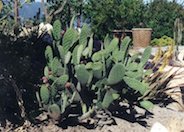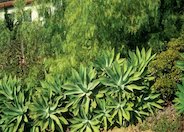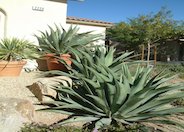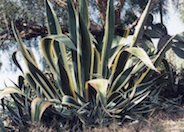
Common name:Indian Fig Prickly Pear
Botanical name:Opuntia ficus-indica
This Opuntia is more tree-like than other types; it grows to15' tall. It usually has no spines but some glochids can be found. Flowers are yellow to orange in late spring and early summer. Fruit is edible. It does best in full sun and is frost sensitive. It needs well drained soil. The major pest and source of the red dye cochineal comes from a scale.

Common name:Fox Tail Agave, Velvet Agave
Botanical name:Agave attenuata
This Agave has a dramatic tropical form. Even light frost can damage its succulent leaves. It is great for containers. In the low desert, partial sun will be best. If it becomes top heavy, simply cut and stick in the ground to root. It is not a fast grower and has light green foliage. It will also die after flowering but pups around the mother will survive. Distinctive with its large rosette of leaves perched on a long curving trunk, it is a native from Mexico.

Common name:Smooth-edged Agave
Botanical name:Agave weberi
This is a striking medium-sized Agave that can grow to 5' tall by 6'-10' wide. This agave has very fine marginal teeth and is sometimes spineless. Supplemental summer watering can prevent yellowing from heat stress in the summer. These plants are also moderately cold hardy and tolerant of temperatures down to 12 degrees F. It is more refined looking than americana. It is native in central Eastern Mexico. It is one of the largest of the Agaves.

Common name:Lavender Cotton
Botanical name:Santolina chamaecyparissus
This ground cover/small shrub will grow to 3' tall and has small, grayish silver leaves with yellow flowers that bloom in the summer.

Common name:Variegated Century Plant
Botanical name:Agave americana 'Variegata'
This Agave has a creamy yellow margins around the edge of the leaves. It will grow 6'-10' tall by up to 13' wide. It is native to Mexico. It has a very open growth habit, with leaves that recurve along their length.
| Designer: | Old Mexico Rancho Look |
Photographer: GardenSoft |
Soils and Compost:
Incorporate compost 6" into your soil to retain water, reduce compaction, feed earthworms, and provide valuable nutrients to your plants.
Integrated Pest Management:
Drip and other smart irrigation delivers water directly to roots, allowing no excess water for weeds.

